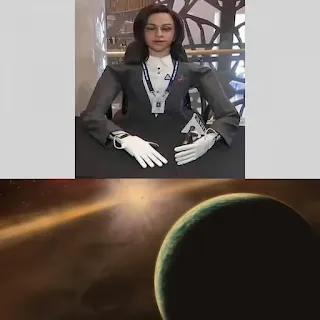India plans to launch a human-like robot into space in the third quarter of 2024, to test the life support systems of the Gaganyaan spacecraft before it launches a man into orbit.
State Minister Jitendra Singh, who oversees the nuclear and space industries in the Indian government, speaking to reporters, indicated that the mission of the robot, called “Vomitra,” which India plans to launch in the third quarter of 2024, will be to test all life support systems in the country. The Gaganyan spacecraft before its manned launch into space.
It is noteworthy that the name of the robot is derived from two Sanskrit words - “vyom” (“space”, “cosmos”) and “mitra” (“friend”). He has the image of a woman, is fluent in several languages, and can answer questions, including those related to the technical condition of the vehicle.
“The Viumitra robot is designed to mimic human functions in a space environment and interact with life support systems,” says Jitendra Singh. Pointing out that the robot can monitor the indicators of the orbital module and control the six sections of the spacecraft. This is the main test before the flight of the first national space crew.
According to the head of the Indian Space Research Organization (ISRO), Sridhara Panicker Somnath, India plans to send its first crewed spacecraft into orbit by the end of 2025.
It is noteworthy that Indian Prime Minister Narendra Modi had announced in August 2018 that one of the astronauts would go into space carrying the national flag of India by 2022 as part of the activities celebrating the 75th anniversary of freedom from British colonial rule. But due to the Covid-19 pandemic, everything was postponed.
The discovery of a “super-Earth” that could host life, 137 light-years away
NASA has discovered a "super-Earth", 137 light-years away in the habitable zone, which could be a promising candidate for life.
The exoplanet is called TOI-715 b, and it is 1.5 times larger than Earth, and orbits a small red star that can emit the right temperature to form liquid water on the planet’s surface, a key element to support life.
Exoplanets are worlds outside our solar system that have been studied since 2018 by instruments such as NASA's James Webb Space Telescope (JWST), allowing astronomers not only to discover new worlds but also to reveal some of their intrinsic properties.
The Transiting Exoplanet Survey Satellite (TESS) was launched six years ago to observe these planets orbiting stars like our sun.
An international team of scientists led by the University of Birmingham used a range of ground-based telescopes to narrow down the location of TOI-715 b once TESS transmitted evidence of its existence.
The team found that TOI-715 b's orbit is narrow, meaning that it completes one orbit (or one year in Earth terms) every 19 days.
However, it also means that one side of the super-Earth always faces its star, which means temperature differences can vary greatly depending on location, affecting climate and weather.
TOI-715 b orbits a red dwarf, which is smaller and cooler than the Sun. According to NASA, these stars are known to be “the best bet for finding habitable planets.”
The agency added: “These planets have much closer orbits than those orbiting stars like our Sun, but because red dwarfs are smaller and cooler, the planets can cluster closer together and remain safely within the star’s habitable zone.”
The same system may also harbor a second Earth-sized planet.
According to scientists, if they can confirm the existence of the second Earth-like planet within the orbit of TOI-175 b, it will be the smallest planet in the habitable zone discovered by TESS so far.
NASA said: “The planet TOI-175 b joins the list of habitable zone planets that can be closely examined by the James Webb Telescope, perhaps even for signs of an atmosphere.”
Although the discoveries of super-Earths (also called super-Earths or super-Earths) are unique in many ways, exoplanets in and of themselves are not unusual. NASA has discovered more than 5,000 such planets and confirmed that they likely exist. More than a trillion exoplanets in the Milky Way alone.
The first exoplanet was discovered more than three decades ago, giving astronomers hope that other planets could harbor life.
Not all giant terrestrial planets are candidates for life, as some host extreme temperatures while others may be completely covered in water or have active lava flows.
"We don't know much about giant planets because we don't have one in our solar system," Chris Impey, a professor of astronomy at the University of Arizona, told Mashable.
But if there's one thing that's certain, said Renyu Hu, an exoplanet researcher at NASA's Jet Propulsion Laboratory: "They are really very exciting planets."
Tags:
science




